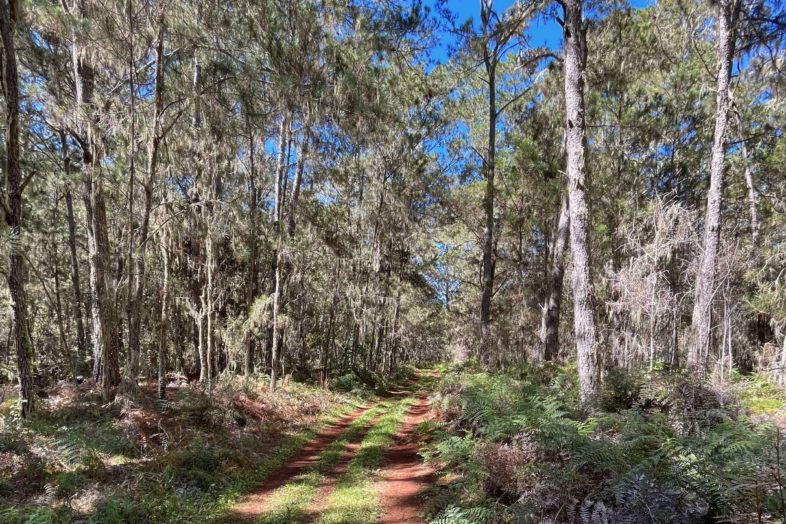
Endemic Hispaniolan Pine forest
Scraping ice off my gear bag was not how I imagined mornings would begin when I set out last month with three VCE colleagues to our Dominican Republic field site. It was my first trip to the DR, rumored to be a tropical nation, and my companions were VCE’s Caribbean Conservation Coordinator Jim Goetz, Staff Biologist Kevin Tolan, and Director Emeritus Chris Rimmer, who led the trip. Our mission was to net, tag, and release Bicknell’s Thrushes (BITH) in the Sierra de Bahoruco National Park. We camped at about 1,600 m, where afternoon temperatures reached a glorious 70-something and where Chris had casually mentioned, “it might get a little chilly at night.”
After a morning spent birding the runways of Logan Airport (Northern Harrier, Rough-legged Hawk, Snow Buntings), a few hours of delay on the tarmac, and a long flight perusing Field Guide to the Birds of the Dominican Republic and Haiti, we landed in Santo Domingo brimming with anticipation. Freezing temperatures were still far from mind the next day as our colleagues from the conservation non-profit Grupo Jaragua (GJ) welcomed us with coffee and pastries at their headquarters in the city. After brief introductions and happy reunions between long-time associates, we piled into three small trucks with a week’s worth of field gear, food, and water. Twelve of us, plus Mila the dog, set off in a caravan along the sunny coast to the country’s southwest corner.
The air conditioner was on full blast when we traversed a sunbaked, checkered landscape of tropical dry forest and cropland and then reached GJ’s field station in Oviedo. This town, located about seven kilometers from the Caribbean Sea, has no water supply. The few drilled wells are saline, like the nearby Laguna de Oviedo. Water is trucked each week to serve the town’s 11,000 residents. That did not stop the generous GJ staff from providing a wonderful, home-cooked lunch of eggplant stew, rice and pigeon peas, guavaberry juice, and the largest avocados I’d ever seen. The lack of fresh water has not deterred the government from planning to construct an airport in this municipality, which will displace dozens of families. Where will they go? There is no easy—or specific—answer to this question, although vague assurances of compensation give some hope and leave others skeptical.
GJ operates a native plant nursery at this field station—a testament to the wizardry of their water conservation practices—and we enjoyed a lesson on adaptations of and threats to some of the endemic plants, as well as GJ’s strategies to conserve them. Our bellies full and spirits high, we added a few more members to our traveling band, loaded more gear, and were off again. As dusk descended, we passed through the cactus-studded, tropical dry forest of Jaragua National Park, the namesake of our partner organization. Our drive through this area of the UNESCO Biosphere Reserve provided only a tiny glimpse into the natural marvels that warrant conservation in this region. The park encompasses a phenomenal diversity of habitats, including unspoiled coral reefs, calcareous cave systems, lagoons, mangroves and other wetlands, as well as Important Bird Areas and many IUCN Red List species in danger of extinction.
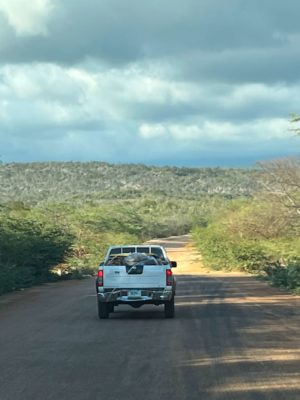
Driving the Alcoa Road with the Sierra de Bahoruco obscured by clouds in the distance.
Turning north from the coast, we followed the Alcoa Road into foothills of the Sierra de Bahoruco. The Aluminum Company of America (Alcoa) developed a bauxite mine there in the 1950s, and that mine operated until the 1980s. The road begins as a smooth, two-lane gravel highway, but the surface narrows and ruts as it continues up past the mine. The ride would be a heap of fun on a dirt bike. In a truck, it becomes more of an adventure.
We arrived at our field site, Pueblo Viejo (18.207N, -71.535 W), well after dark and arose before dawn to discover ice-encrusted gear! It turns out that a “polar air mass” arrived in the DR on the same day that we did. We camped in a clearing, the legacy of a logging and milling settlement abandoned close to 40 years ago. Hispaniolan pine forest surrounded us, in some places savannah-like, in others a dense and nearly impenetrable tangle of thorny vines. Throughout the forest, a foot-deep layer of pine needles blanketed craggy limestone bedrock. There was no source of drinking water and no flowing water of any kind. Our Dominican partners had shopped and packed provisions for the week, including 5-gallon jugs of water, a bushel of huge avocados, cases of mangoes and pineapples, and of course, shade-grown coffee. We may or may not have enjoyed a loaf of home-baked crusty bread carried from Vermont and a precious wheel of Manchego cheese brought by a field crew volunteer and employee of the German Cooperation Agency´s mission in Haiti, Egido Sanz, from her family’s home in Spain. I’ll never tell.
Steps away from our tents, just uphill, lay the montane broadleaf cloud forest, a forest type that harbors a significant share of the global population of wintering Bicknell’s Thrush. A more closed canopy than the pine forest, with a thicker understory of vines, thorny shrubs, epiphytic plants, and plenty of “coarse woody debris” made moving through these woods a workout. Chilly fingers and chattering teeth notwithstanding, we set about to scout netting sites, serenaded on both sides of the night by the ethereal Rufous-throated Solitaire. Chris and his field team (including some of VCE’s co-founders and Estéban Garrido, one of his long-time Dominican field associates) established bird survey transects here two decades ago, and we spent our first day relocating those and reopening net lanes wherever we heard BITH calls.
Unique among many birds, male Bicknell’s Thrushes do not defend territories on their breeding grounds, but they do establish and defend territories in winter. To locate our subjects, we explored trails and roads in the broadleaf habitat, playing the BITH call on a speaker. If a male was nearby, he’d respond to the call (as in, “Hey, this is my territory, move along!”), and we’d then set about to capture him. This involved clearing net lanes, setting up 12-m mist nets (which resemble large hair nets stretched between two poles), and leaving a speaker nearby broadcasting the call of a BITH. With any luck, a nearby bird would respond to our audio lure, and our net would intercept him. Unlike our summertime banding station on Mount Mansfield, we were only banding BITH on this trip. Other species were admired (that’s an understatement) and released, like this Narrow-billed Tody.
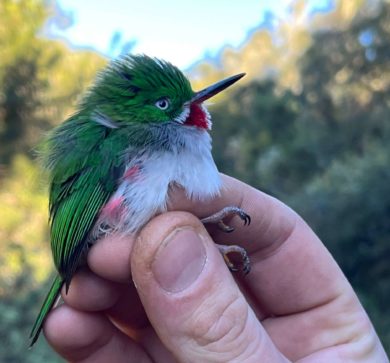
The endemic Narrow-billed Tody is about to be released on a chilly morning.
Over our five days in Bahoruco NP, we located, captured, and tagged 14 BITH. Each bird received a band, as they would if we caught them on Mount Mansfield during the summer, as well as a “nanotag.” The nanotag is about the size of a hearing aid battery, carried like a backpack by the bird and affixed via a harness made of a stretchy fishing line-like material looped around each leg, with a very light and flexible antenna about 20 cm long that trails behind the bird. Each tag has a unique signature and can be detected by the network of Motus towers erected across the eastern seaboard of the US, Canada, and the Caribbean. When a tagged bird passes within about 15 km of a tower, this datapoint is registered, providing one more bit of information about the bird’s travels. This study will help to clarify the migratory pathways of BITH from their wintering grounds to their breeding sites. Research over the past 30 years has elucidated breeding and wintering territories, but comparatively few details are confirmed about this species’ migratory routes. (Click here to watch Chris Rimmer and Kevin Tolan affix a nanotag to a Bicknell’s Thrush, with Chris narrating in English. Click here to see the same process, with Estéban Garrido narrating in Spanish.)
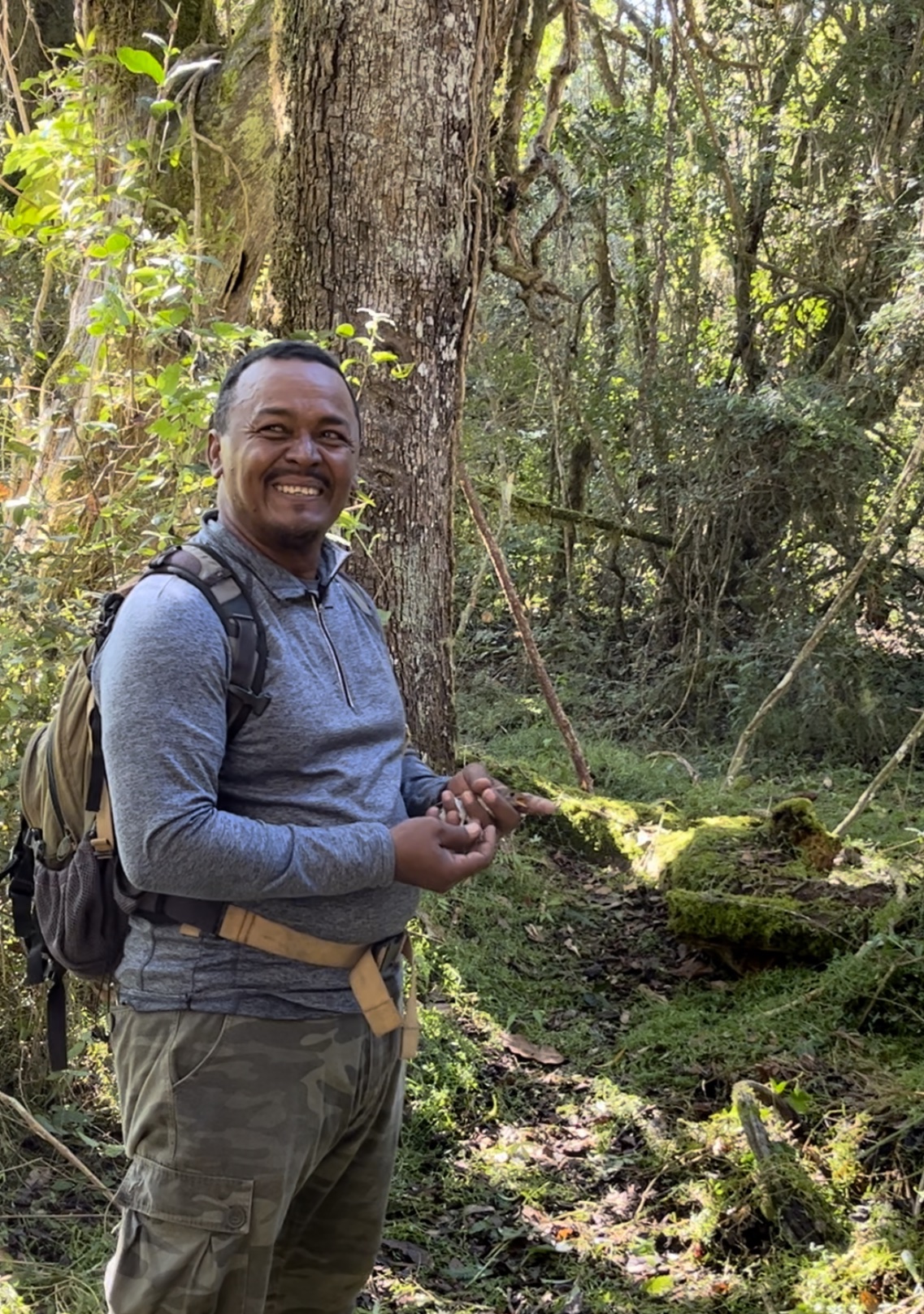
Long-time VCE colleague Estéban Garrido releasing a tagged Bicknell’s Thrush
One of the best parts of the trip for me—aside from seeing Chris at work in the place that has fueled his passion for the better part of 30 years—was the opportunity to spend time with our Dominican partners on their own turf, to learn about their goals, interests, and challenges. We thrashed through the woods together, huddled around the campfire, laughed and puzzled through language barriers, and celebrated every BITH capture.
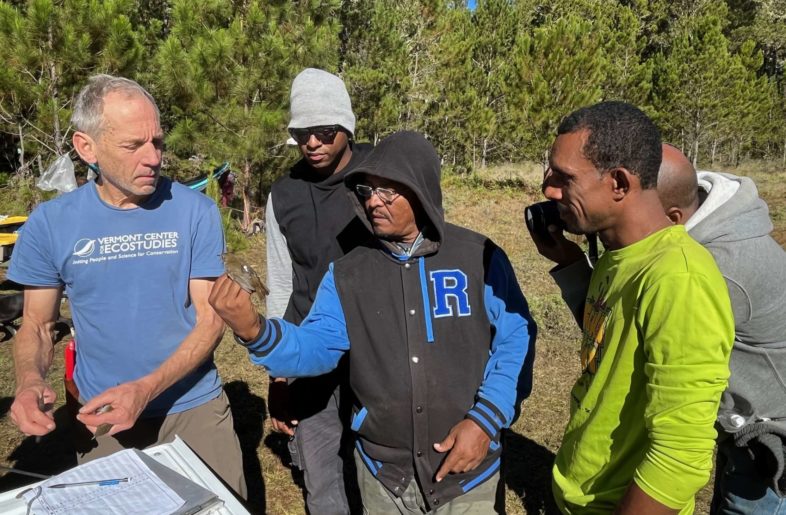
Estéban Garrido handles a newly-tagged Bicknell’s Thrush while Chris Rimmer and colleagues look on.
Yolanda León is president of the Grupo Jaragua board (and sits on VCE’s Advisory Council as well). A visionary and dedicated conservationist, she manages somehow to lead GJ field projects, conservation strategy, networking, and lobbying, not to mention managing budgets and mentoring staff, remaining diplomatic, determined, optimistic, and fearless in the face of discouraging trends, systemic corruption, and repeated David vs. Goliath challenges. This is a volunteer gig for her; she is a professor at INTEC university in Santo Domingo. Through our conversations, I wanted to better understand what a partnership with VCE looks like from GJ’s perspective and how their support of our research and conservation projects resonates with their own organizational goals. What’s in it for them? I also had the chance to share with Yolanda some of the work we are doing with respect to diversity, equity, and inclusion and to inquire how VCE and other organizations from the US come across. What mistakes do we make? What should we know that we aren’t recognizing? How could we do better, to be more effective partners, to better support their mission while still pursuing our own?
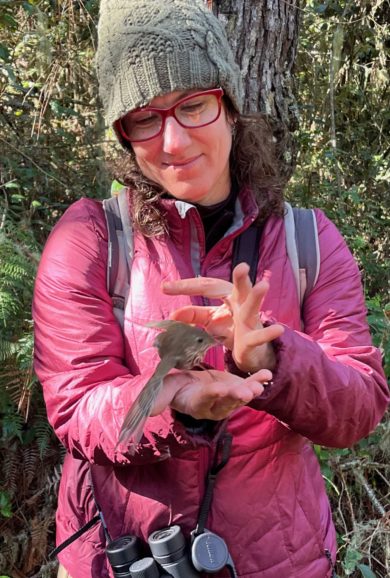
The moment Yolanda León lifted her hand, the tagged Bicknell’s Thrush took flight.
GJ shares VCE’s commitment to Bicknell’s Thrush conservation not necessarily because the BITH is a conservation priority for them (there are 33 bird species that occur nowhere else on the planet, after all, and countless other species as well), but because—at least, in part—efforts (and dollars) for BITH benefit many of the DR’s endemic and endangered species that take refuge in Hispaniola’s critically threatened broadleaf and cloud forests. Aside from bringing our own projects to the DR, though, VCE has partnered with GJ and others to advance on-the-ground conservation projects and initiatives that build local conservation capacity. This happens through individual mentoring, fund recruitment, and conservation planning support.
Currently, Grupo Jaragua is fighting government plans to build a cruise ship port in Pedernales, a remote town near the Haitian border with an unspoiled coral reef and a designated Ramsar Convention Wetland of International Importance. GJ is leading, with support from VCE and funds provided by Canada’s Ministry of the Environment and Climate Change, an effort to restore broadleaf forest lost to agricultural conversion and to permanently and effectively conserve land that is already technically, if not effectively, included within the boundaries of the Sierra de Bahoruco National Park. GJ is also battling the tidal wave of industrial avocado farms being established within the national park itself, an industry that exploits day laborers who cross illegally from Haiti and operates brazenly within the park boundary. They are raising awareness of the illegal parrot pet trade, which is driving the endemic Hispaniolan Parrot towards extinction by removing entire clutches of nestlings and destroying nesting sites. And yet, while their own project needs loom large and daunting, when it came time for a VCE field effort in early 2023, seven Dominicans, including the GJ board president and several field biologists, along with Lemuel Familia, a lively, young biologist from the DR’s Ministry of the Environment, turned out to join our field crew.
Our conversation about diversity, equity, and inclusion confirmed that VCE’s collegial and welcoming values govern our interactions in the DR just as they do closer to home. While I might have expected the racial differences between VCE staff and our DR partners to be the key area for improvement, this was not the case. In fact, creating opportunities and pathways for young women in the DR into conservation science careers is a challenge, and one observation was that VCE’s field crews are almost all males. Evening out the gender diversity on our science team is certainly an internal goal for VCE, and it was especially enlightening to me to learn that our own lack of diversity might contribute to, or at least perpetuate, that same challenge for our DR partners. I learned about some of the cultural and practical hurdles that can keep young women in the DR from careers in conservation. Surmounting those hurdles takes a commitment of extra time and effort, as well as intentional planning, and can make all the difference. Having international partners show up with a gender-diverse team models the possibilities, and having international partners who are willing to commit the extra time and resources to engage gender-diverse field crews on the ground in the DR would be ideal. These suggestions were offered sincerely and without judgment, and our team at VCE will integrate what we learned and look for opportunities to progress in how we engage internationally.
What began some 35 years ago as the life work of VCE’s retired founding director has led to a partnership that goes far beyond understanding and conserving Bicknell’s Thrush. Grupo Jaragua has emerged as a key conservation leader in the Dominican Republic, safeguarding habitats, problem-solving, and engaging people across the southwestern portion of the country and in the capital as well. In fact, one could say they embody VCE’s own tagline of “uniting people and science for conservation,” making them a natural partner for VCE in our tropical home-away-from-home.
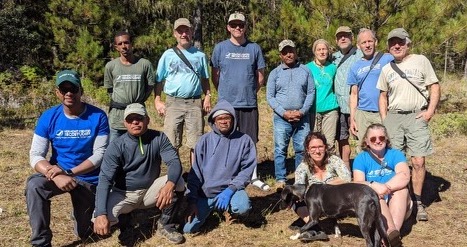
The field team at Pueblo Viejo in the Sierra de Bahoruco, grizzled but happy after five days of field work.
This was a wonderful opportunity to experience the Sierra de Bahoruco landscape, participate in the next research frontier in Bicknell’s Thrush ecology, and share it all with a group of talented conservationists who model extraordinary commitment and determination to protect their exquisite, endangered, and unique island landscape. At week’s end, just as the polar airmass lifted and the weather returned to normal, we retraced our steps to Santo Domingo, and I flew home while my colleagues ventured north to Reserva del Zorzal in the Cordillera Septentrional for another week of BITH tagging. Look for a field dispatch from Kevin Tolan with the results from that week and a look ahead to the summer’s complementary work on Vermont’s Mount Mansfield.

THANK YOU for taking us on another BITH adventure and sharing your insight and experiential ‘take aways’ from this historic relationship with GJ.
The perfect thing for a miserable icy Vermont day!
Thank you Susan, for this wonderfully crafted account! Not only is the complex set of relationships that make VCE’s BITH research possible illuminated, but the whole idea of an ‘Anglo’ presence as a political matter in a developing country is faced head on, and given significance. My respect for VCE just increased, if possible! And all for the sake of what Vermonters really do care about most, I would say with confidence: the birds, the hills, this world under threat.
And so cool to see the Dominican partners and learn what they do!
I very much enjoyed Susan Hindinger’s report on VCE’s recent return to the Dominican Republic with Chris Rimmer, and am gratified that research on the Bicknell’s Thrush continues to inform the species’ habits and prospects. Keep up the good work!
Interesting.